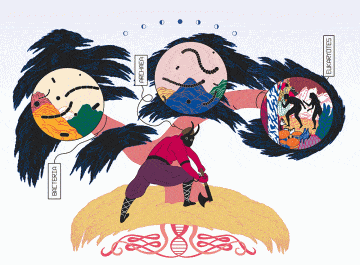Traci Watson in Nature:
 Every mythology needs a good trickster, and there are few better than the Norse god Loki. He stirs trouble and insults other gods. He is elusive, anarchic and ambiguous. He is, in other words, the perfect namesake for a group of microbes — the Lokiarchaeota — that is rewriting a fundamental story about life’s early roots. These unruly microbes belong to a category of single-celled organisms called archaea, which resemble bacteria under a microscope but are as distinct from them in some respects as humans are. The Lokis, as they are sometimes known, were discovered by sequencing DNA from sea-floor muck collected near Greenland1. Together with some related microbes, they are prodding biologists to reconsider one of the greatest events in the history of life on Earth — the appearance of the eukaryotes, the group of organisms that includes all plants, animals, fungi and more.
Every mythology needs a good trickster, and there are few better than the Norse god Loki. He stirs trouble and insults other gods. He is elusive, anarchic and ambiguous. He is, in other words, the perfect namesake for a group of microbes — the Lokiarchaeota — that is rewriting a fundamental story about life’s early roots. These unruly microbes belong to a category of single-celled organisms called archaea, which resemble bacteria under a microscope but are as distinct from them in some respects as humans are. The Lokis, as they are sometimes known, were discovered by sequencing DNA from sea-floor muck collected near Greenland1. Together with some related microbes, they are prodding biologists to reconsider one of the greatest events in the history of life on Earth — the appearance of the eukaryotes, the group of organisms that includes all plants, animals, fungi and more.
The discovery of archaea in the late 1970s led scientists to propose that the tree of life diverged long ago into three main trunks, or ‘domains’. One trunk gave rise to modern bacteria; one to archaea. And the third produced eukaryotes. But debates soon erupted over the structure of these trunks. A leading ‘three-domain’ model held that archaea and eukaryotes diverged from a common ancestor. But a two-domain scenario suggested that eukaryotes diverged directly from a subgroup of archaea. The arguments, although heated at times, eventually stagnated, says microbiologist Phil Hugenholtz at the University of Queensland in Brisbane, Australia. Then the Lokis and their relatives blew in like “a breath of fresh air”, he says, and revived the case for a two-domain tree.
More here.
